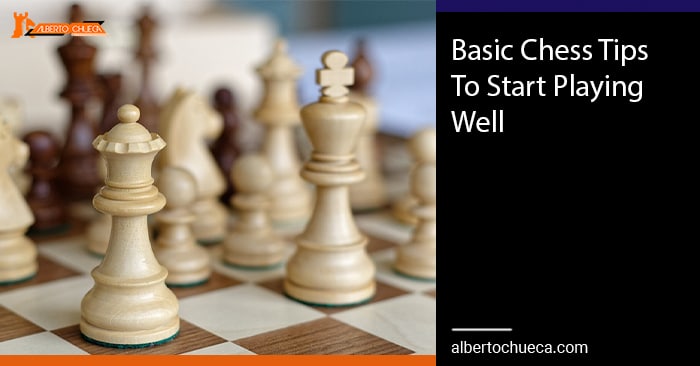Table of Contents
Basic Chess Tips
I'm going to give you a list of 20 basic chess tips that you should know to play better at chess but first of all, I must explain to you what the sport of chess is. This sport is an activity between two people who have 16 pieces placed on a board and move according to the rules. The board has 64 squares.
The game takes place on an 8×8 square board. The squares alternate black and white shades. These 64 squares are possible positions that the pieces can take during the game.
At the start of the game, each player has 16 pieces that are hierarchically divided as follows: the king, the queen, 2 bishops, 2 knights, 2 rooks and 8 pawns.
Movements and captures
The movements and captures of each are:
The king moves a single square in any direction, but you must remember that you must not put him in danger of being captured.
The queen moves in a straight line either diagonally, vertically or horizontally for as many squares as you wish.
The bishops move diagonally by the number of squares you want as long as they are the same color.
The knight moves in an L-shape with 3 vertical and 2 horizontal squares.
The rooks are moved by the number of squares you want as long as it is horizontal or vertical.
The pawns to start their movements can move two squares to the front, once they make their first move they can only advance one square. In addition, it is the only piece that does not make its capture in direction to its displacement, to capture it moves a square diagonally.
It is a strategy game since its main objective is to overthrow the king of the other team. To achieve this, you must threaten the square where the king is located with some of your pieces.
You will have achieved the objective when your opponent does not find any way to protect the king. Whether he places a piece to protect it, moves it, or captures your piece. If your opponent can't make any of these moves, you've achieved a checkmate by ending the game and getting your victory.
The game of chess is not as simple as it seems, this is a mental sport. You must develop a very good strategy to achieve the objective and not just move your pieces in a random way. For this reason, I bring you different techniques that will help you to train yourself to carry out a good game.
If you want to avoid big mistakes at the opening in a chess game, you can follow as general rules the next tips (there are always exceptions). Sure you know many of these basic chess tips but they are quite important. The masters sometimes forget them also:
Chess Tips In the opening
- Try to control the center since the beginning (the four center squares: e4, d4, e5, and d5)
- Start moving your minor pieces (bishops and knights) into a good position so they can control the important squares- the ones in the center- in the chessboard. For example: for the white knights, place them in the squares f3 and c3; as for the black knights, place them in the squares f6 and c6. Oh! And don’t move the knights to the corners of the board!
- Don’t move the same piece more than once during the opening! This wastes an important developing time.
- Don’t move only the pawns during the opening. Concentrate on developing other pieces and only move the pawns to allow the others’ development.
Chess Tips To attack
- Try to take the initiative and play dynamically.
- Do not attack before you have developed all your pieces.
- Don’t be materialistic and capture too many pawns instead of developing pieces in the opening. In general, is very dangerous.
- Keep in your mind the sacrifices and gambits, to play with them or against them. Put attention in the unbalanced positions of material.
- Try to find the tactic in the position. Almost every tactic is made up of patterns or basic moves that repeat frequently.
- Value properly your pieces and your opponent’s. When you’re thinking about sacrificing some of your pieces, you should firstly think of their real value and not on the amount.
- Develop quickly and correctly the pieces. Time is quite important in chess.
Common mistakes
- Try to castle in the correct moment. Don’t wait until it’s too late.
- Don’t take out the Queen too soon. Move your knights, bishops and rooks, and put your King someplace safe (the King must always be well protected).
- Look at the entire chessboard! Let’s be real, we all make the same mistake. Attacking the King has always been the main focus of our attention, but we shouldn’t always pursue the same objective. Having a good and strategic position is also important.
This is a common problem for amateurs and professionals alike. We tend to focus all our attention on the part of the board where the action is occurring, so we can lose advantage on the other side. That’s why it is so important to keep an eye on the entire chessboard at all times.
- Have a plan. If you threat something on one side in one movement, then it will be easy for your opponent to defend himself. You need to have long-term plans as well.
To keep in mind
- Practice tactical exercises! This may seem obvious but is still overlooked by many chess players. The more problems you solve, the more patterns you will acquire, and, as a result, you will see the tactics quicker and easier.
- Watch your opponent’s movements. Each time your opponent makes a move, you need to stop and think: what is the threatening and what does he want to do?
- Think about endgames. Since the moment the match begins, you need to remember that every move you make can potentially affect your probabilities in the endgame.
- Always stay alert. People tend to either relax once they reach a good position or lose hope and quit when they’re in a bad one.
- WATCH YOUR BACK! And your front! When your turn comes, always ask yourself: what is my opponent threatening? Is he preparing traps to capture my pieces? Then, react accordingly.







